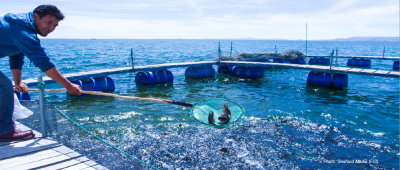PERU: According to Produce, in Peru, artisanal fishing and aquaculture contribute 65% of hydrobiological products intended for direct human consumption; that is, it supplies 2 out of 3 of these products that are consumed in the country and takes advantage of nearly 300 species of the thousand available in the Peruvian sea, promoting the diversified consumption of marine biodiversity.
According to the FAO, Peru is the country with the highest consumption of fish in South America with 23 kg per capita per year (2021). Consequently, landings for direct human consumption have increased by 43.9% from 2010 to 2019. However, 39% of producers do not have preservation systems (such as the cold chain) and 84% do not have Sanitary authorization, which increases the risks for human consumption and puts productivity at risk, especially of small artisanal fishermen.
Also, the growth of artisanal fishing and aquaculture has not been sustainable. According to the World Bank, they maintain a high degree of informality with more than 60% of vessels without valid fishing permits and without reporting their catches. To a large extent, this precarious situation has been generated by the lack of attention regarding the development of good practices in artisanal fishermen and aquaculturists, triggering problems of overexploitation. This difficulty, in turn, produces an ecosystem imbalance that causes a decrease in the biomass of marine species.
For this reason, it is necessary to implement a systemic approach in these productive activities, taking into account the environmental alterations caused by overexploitation and limited control. Otherwise, since artisanal fishing and aquaculture are a substantive part of the national diet, there would be serious risks of access to healthy food in the future, as well as in labor matters for the more than 74,000 artisanal fishermen in the country and for the thousands of aquaculturists and mariculturists.
Due to the aforementioned, the FAO is committed to an approach to transforming the production and consumption systems of artisanal hydrobiological products based on the installation of a multisectoral vision that promotes direct human consumption of these. For this, it is necessary to pay special attention to the Andean and high Andean areas that present the lowest per capita consumption at the national level (less than 15 kg per capita, compared to the high values in the coast and jungle, which exceed 30 and 40 kg respectively in the regions with the highest consumption). It must be remembered that in these areas the triple burden of malnutrition – food insecurity, malnutrition and overweight – is evident, with high rates of anemia and chronic child malnutrition, so that an improvement in access to hydrobiological products would have a positive impact. At this point, Andean artisanal fish farmers, mainly trout, play a key role in improving direct human consumption in these regions with high potential for this activity.
Likewise, to manage the promotion of consumption, it is necessary to generate better production. As mentioned above, this task requires a systemic approach involving monitoring and control of artisanal fishing and aquaculture. Therefore, it is necessary to promote governance schemes that encourage research and innovation in these chains in order to assess the impacts on aquatic ecosystems, improve real-time traceability systems, promote short marketing circuits and strengthen waste management. and waste of hydrobiological products. On this last point, it also opens up the possibility of creating a link between family farming and artisanal fishing and aquaculture by transforming the waste from these activities into organic fertilizers, which is particularly attractive given the difficulties of access to chemical fertilizers that the country currently faces.
Since 2022 is the International Year of Artisanal Fisheries and Aquaculture, it is key to recognize the role that these activities play in food security in Peru and their contribution to achieving Zero Hunger. For this, it is necessary to systematize actions from different fronts, articulating institutions in a multisectoral and multilevel manner, and always with the participation of small fishermen.
Source: El Peruano

